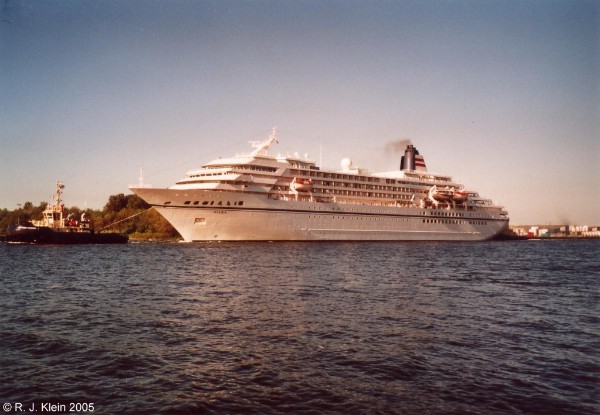
In 1989 Nippon Yusen Kaisha, or NYK Lines, started up a new cruiseline under the Crystal Cruises name. They introduced quite a big liner named Crystal Harmony of 48.000 tons. Other Japanese lines followed swiftly with Mitsui OSK Lines introducing Nippon Maru a modest 21.000 ton cruiseliner in 1990, followed by Orient Venus of Japan Cruise Line, also known as Venus Cruise. Apart from Crystal Cruises, most companies concentrated on Asiatic Cruises with 20.000 to 30.000 ton liners but these new ships gave Japan a real cruiseboost.
Asuka floated out at the 6th of april 1991. The design of the ship, produced by Toshio Nagao from the Kenmochi Design Laboratory in Japan, was influenced by two earlier ships, both built outside Japan. The first was the Royal Princess from 1984, that was built at the Wärtsilä yards in Finland, and the second was the Crown Odyssey, built in 1987 at Jos L. Meyer's at Papenburg, and now sailing as Balmoral for Fred. Olsen. From Royal Princess, Asuka inherited the all-outside cabin concept. The same design was also used for the ships of the other Nippon Yusen Kaisha-brand, Crystal Cruises. When you compare these ships, there are very easily recognizable similarities. The only thing that really differs is the design of the bow, that is on Asuka totally out of proportions to the superstructure, and it gives the ship her typical overbite. The first cruise of Asuka started in december 1991 from Yokohama to Taiwan and she was also sailing Asiatic cruises for most of her carreer, that only brought her as far as Australia. She was built for the Yusen Cruises Company Ltd., that was a part of NYK, just like the Crystal Cruises fleet that was expanded in 1995 with Crystal Symphony. Asuka was the only ship sailing for Yusen Cruises and because of that, this NYK cruisedivision is also known as Asuka Cruise. Nippon Yusen Kaisha itself is a part of the Mitsubishi company and this mothercompany is linked in every way to the ship. The order for Asuka was placed with the Mitsubishi Heavy Industries yards, of course part of Mitsubishi. The bank loans were provided by the Mitsubishi Bank, the enigines were designed by MAN but built by Mitsubishi. The interiours of the ship, mainly the furnishings, the paint and the carpetting, were all provided by companies within the Mitsubishi group. Asuka flew the Japanese flag with her homeport being Tokio untill 2005. After that, NYK needed a larger ship because of a rapidly growing demend for her cruises. Asuka was replaced by Crystal's Crystal Harmony from 2006 onwards. Therefore, the bigger ship was remaned Asuka II. Just before being transferred, Asuka came to Europe for the first time. At the 12th of march 2006 the former Asuka started cruising for the German operator Phoenix Reisen as their Amadea and sails worldwide cruises under their banner. The name Amadea is the latin name for Amanda and it means 'God's love'. It can also be seen as the female name for Amadeus. Phoenix Reisen had rebuilt the ship a bit, where she recieved some inside cabins, as well as some balcony-cabins. In all, some 50 passengers more could now be sailing the ship.
Below, Amadea is shown sailing the Northsea Canal from Amsterdam at the 17th of may 2011.
Anyone who can name five great Japanese liners from the twenties, please send me an email. Japanese shipping is not that well known in Europe or America, also not with me. But we have to admit, a big country only existing out of islands has a great maritime tradition and passenger shipping is one of them. But the fact is, we don't see many Japanese passenger liners in the western waters. One of the reasons is that Japanese passengerlines started building new ships to replace a few old ones only in the beginning of the nineties in a somewhat larger scale.


